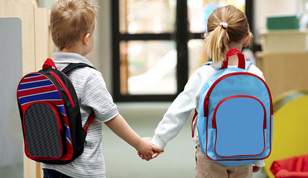Blog Categories
Search Blog
Blog Categories
Back to School and Mental Health: Working Together During Unprecedented Times
There is something that is so special to me about back to school. I’ve always loved it. As a kid I always loved my big school supply shop in August (still do!). I loved the fall air and cozy clothes, and I always loved the exciting anticipation of what the school year would bring. Who would my teachers be, which friends would I make? Since having kids, these warm feelings have come back… and then some (cue the stress!). And that was before the pandemic. This year has been, and will continue to be, strange, to say the least. But more and more I find myself thinking about these times in relation to my community. My fellow parents, teachers, administrators, health care colleagues and of course, our children. COVID-19 is here, and likely will be for some time. So how do we navigate it all? What can we do to help each other and our children in these unprecedented times?
Children’s Mental Health Ontario has prepared a “Back-to-School Mental Health Kit” (September, 2020) that is filled with resources and tips for parents whose children require support at school. In fact, it has excellent tips for managing school during these times, whether your children require extra support or not. Click here for the full report.
I have attempted to summarize their tips below as well as give some attention as to how we can extend these tips. Let’s think about how can support our children, but also our teachers and everyone else involved in the school community.
- Acknowledge the Extent of the Challenge. What is possible this year for students and for teachers? Policies and protocols keep changing. At Boomerang Health we’ve updated our policies multiple times since the pandemic hit! Children are trying to understand their new worlds, as are teachers. Let’s be patient and understanding. Everything is new for all of us. None of us know what this “new normal” will look like just yet. None of us planned for this and everything is evolving. I often try to think about how this will play out or what challenges may lie ahead, but how can I really know? The challenge is immense and it is important to be realistic.
- Empathize and Communicate. What is empathy? Empathy is not just showing sympathy and saying we feel badly for another person’s experience. Empathy is putting ourselves into someone else’s shoes and trying to understand an experience from someone else’s perspective. What must it be like for a child to suddenly be expected to learn with new barriers in place (literally and figuratively)? What must it be like for a teacher to have to change their teaching practices and find creative ways to engage with children, while making sure the physical health of themselves and their students are not compromised? If we can be mindful of what children and teachers may be experiencing, we can better navigate the issues they are facing and work on solutions together. For example, at Boomerang Health we were noticing how strange it was for our clients to not be able to see our faces. So now we wear buttons with our faces on them! Sometimes understanding an experience can be enough to promote a solution. When a child (or grown-up) feels validated and understood change can start to happen organically.
- Identify Challenges, Brainstorm Solutions. Once you have a solid understanding of some of the barriers and challenges, you can start to work through possible solutions. Here it is important to think outside of the box. Be flexible. If there is one thing that I have learned over these past six months, it is that things that you never thought were possible can quickly become routine. Did you know we have successfully done many virtual physiotherapy sessions at Boomerang Health!?! When we work together, we can figure things out. As I mentioned in relation to empathy above, sometimes the act of acknowledging a challenge, or having insight into someone else’s perspective can be enough. It can be the foundation and necessary element to elicit change. Once you understand the real issue, solutions quickly present themselves.
- Communicate with your Child’s Teacher. Find the right time to express yourself clearly. Be thoughtful about what you really want to say, be kind and respectful in how you communicate what you are looking for. Be open to discussion and expect that you may have to revisit your conversation more than once. Also think about your verbal and nonverbal social cues. How are you expressing yourself through body language? This can be particularly hard through a computer screen or with a mask, no doubt. But the more we can do to show that we are open and responsive to working together, the easier it will be to connect and the more successful our interactions can be.
Wishing everyone a successful back to school, however that may look for you and your family!






